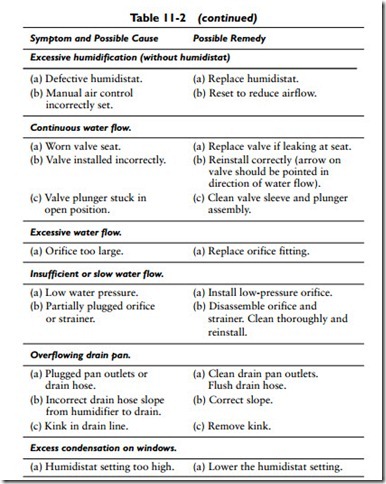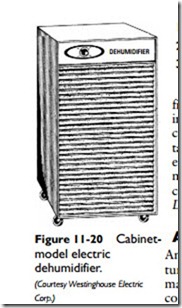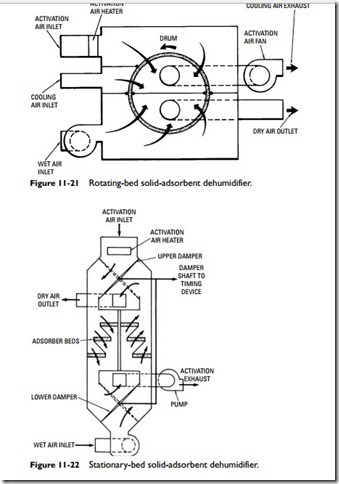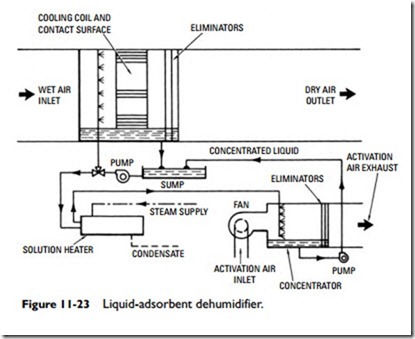Troubleshooting Humidifiers
Table 11-2 lists the most common problems associated with the operation of a humidifier. For each operating problem, a possible cause is suggested and a remedy proposed.
Dehumidifiers
Dehumidification is the name given to the process of removing moisture from the air. The device used for this purpose is called a dehumidifier (see Figure 11-20). Dehumidifiers can be classified on the basis of how they remove moisture from the air into the following three categories:
1. Absorption dehumidifiers
2. Spray dehumidifiers
3. Refrigeration dehumidifiers
Both spray and refrigeration dehumidifiers remove moisture from the air by cooling it. The cooled air condenses and the condensation falls into the dehumidifier tank. Dehumidifiers operating on the refrigeration principle are the type most commonly used in residential heating and cooling systems (see Refrigeration Dehumidifiers in this chapter).
Absorption Dehumidifiers
An absorption dehumidifier extracts moisture from the air by means of a sorbent material. This type of dehumidifier is very common in commercial and industrial installations but is rarely found in residences except in very large houses.
A sorbent material is one that contains a vast number of microscopic pores. These pores afford great internal surface to which water adheres or is absorbed. Moisture is removed from the air as a result of the low vapor pressure of the sorbent material.
Figure 11-21 illustrates the operating principle of a rotating-bed dehumidifier. The unit consists of a cylinder or drum filled with a dehumidifying or drying agent. In operation, airflow through the drum is directed by baffles, which form three independent airstreams to flow through the adsorbing material. One airstream consists of the wet air to be dehumidified. The second airstream is heated drying air used to dry that part of the dehumidifying material that has become saturated. The third airstream precools the bed to permit an immediate pickup of moisture when that part of the bed returns to the dehydration cycle. In the rotating-bed dehumidifier, the baffle sheets are stationary and the screened bed rotates at a definite speed to permit the proper time of contact in the drying, cooling, and dehumidifying cycles.
The operating principles of a stationary-bed solid-adsorbent dehumidifier are illustrated in Figure 11-22. It has two sets of stationary adsorbing beds arranged so that one set is dehumidifying the air while the other set is drying. With dampers in position as
shown, air to be dried flows through one set of beds and is dehumidified while the drying air is heated and circulated through the other set. After completion of drying, the beds are cooled by shutting off the drying air heaters and allowing unheated air to circulate through them. An automatic timer controller is provided to cause the dampers to rotate to the opposite side when the beds have adsorbed moisture to a degree that begins to impair performance.
The liquid adsorbents most frequently used in dehumidifiers are chloride brines or bromides of various inorganic elements, such as lithium chloride and calcium chloride.
A typical liquid-adsorbent dehumidifier is shown in Figure 11-23. It includes an external interchamber having essential parts consisting of a liquid contactor, a solution heater, and a cooling coil, as shown. In operation, the air to be conditioned is brought into contact with an aqueous brine solution having a vapor pressure below that of the entering air. This results in a conversion of latent heat to sensible heat, which raises the solution temperature and consequently the air temperature. The temperature change of the air being processed is deter- mined by the cooling water temperature and the amount of moisture removed in the equipment.
Spray Dehumidifiers
Dehumidification can be accomplished by means of an air washer as long as the temperature of the spray is lower than the dew point of the air passing through the unit. This is an important fact to remember because condensation will not take place if the temperature of the spray is higher than the dew point. Sensible heat is removed from the air during the time it is in contact with the water spray. Latent heat removal occurs during condensation.
Spray dehumidifiers, or air washers, usually have their own recirculating pumps. These pumps deliver a mixture of water from the washer sump (which has not been cooled) and refrigerated water. The mixture of sump water and refrigerated water is proportioned by a three-way or mixing valve actuated by a dew-point thermostat located in the washer air outlet or by humidity controllers located in the conditioned space.
A spray dehumidifier results in greater odor absorption and cleaner air than is possible with those using a cooling coil. A principal disadvantage of this type of dehumidifier is that it sometimes experiences problems with the water-level control and may flood.
Related posts:
Incoming search terms:
- de humidifier plant rotating bed on ship
- de humidifier rotating bed
- troubleshooting industrial refrigeration dehumidifiers
- two parts of rotating bed in de humidifier plant
- two parts of rotating bed of de-humidifier plant
- two parts rotating bed in dehumidifier
- what names are given to the two parts of the rotating bed of de-humdifier on chemical tanker




